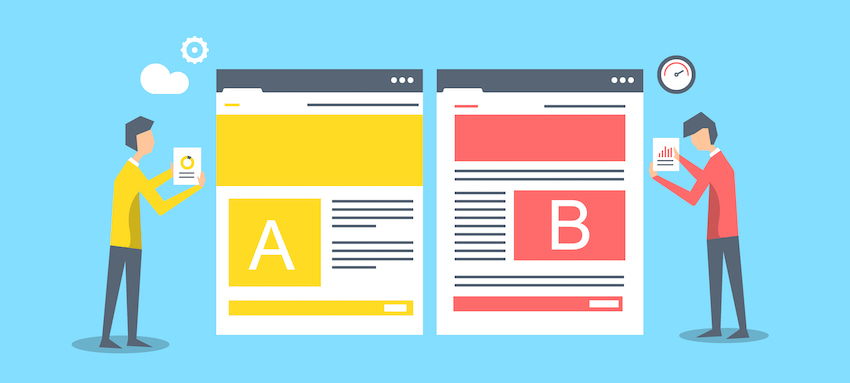03 Apr

Mastering A/B Testing: The Art and Science of Digital Product Optimization
In today’s digital landscape, where user experience reigns supreme, businesses are constantly striving to optimize their digital products to meet the evolving needs and preferences of their audience.
A powerful tool in this field is A/B testing, a method that allows companies to experiment with different variations of their product to determine which performs better in achieving their goals.
In this comprehensive guide, we’ll delve into the art and science of A/B testing, exploring best practices, common risks, and how NBS applies this technique to achieve success for its clients.
A/B testing, also known as split testing, is a marketing experiment wherein you split your audience to test variations on a campaign and determine which performs better. In other words, you can show version A of a piece of marketing content to one half of your audience and version B to another.
At its core, A/B testing involves comparing two or more versions of a digital product to identify which one yields better results. These versions, typically called A and B, are presented to users in a randomized manner, and their interactions are closely controlled and analyzed. The ultimate goal is to make data-driven decisions that improve key performance indicators (KPIs) such as conversion rates, engagement metrics, or revenue.
Best Practices for A/B Testing:
- Clearly Define Objectives: Before proceeding on an A/B test, it’s important to establish clear and measurable objectives. Whether it’s increasing sign-ups, reducing bounce rates, or increasing sales, defining specific goals will guide the entire testing process.
- Focus on Significant Changes: While it’s tempting to test several variations in parallel, it’s advisable to focus on one significant change at a time. This ensures that the impact of each variation can be accurately measured and attributed.
- Randomize and Segment Users: To ensure the reliability of results, users should be randomly assigned to different variations. Additionally, segmenting users based on relevant criteria such as demographics or behavior can provide deeper insights into how different audience segments respond to changes.
- Analyze Statistical Significance: When analyzing the results of an A/B test, statistical significance is essential. Utilize statistical methods such as testing to determine whether observed differences are statistically significant or simply due to chance.
- Monitor Secondary Metrics: While the primary goal of A/B testing may be to optimize a specific KPI, it’s essential to monitor secondary metrics to avoid unexpected consequences. For example, a variation that increases conversion rates may inadvertently decrease user satisfaction.
Common Risks to Avoid:
- Lack of enough Sample Size: A common risk in A/B testing is drawing conclusions based on insufficient data. Ensure that the sample size is large enough to detect meaningful differences with confidence.
- Ignoring variability and External Factors: variability in user behavior due to seasonality or external factors can significantly impact the outcome of A/B tests. Take into account external variables and consider conducting tests over longer periods to account for potential variables.
- Overlooking Long-Term Effects: A successful A/B test in the short term does not guarantee continuous success. Consider the long-term results of changes, and monitor performance beyond the duration of the test to assess their lasting impact.
- Confirmation prejudice: It’s natural to have preferences or theories about which variation will perform better. However, submitting to confirmation bias can lead to selecting data or interpreting results in a way that aligns with preconceived notions.
- Not Documenting Learnings: Each A/B test presents an opportunity to learn valuable insights about user behavior and preferences. Documenting these learnings ensures that future optimization efforts are informed by past experiments, leading to continuous improvement.
NBS Venture’s Approach to A/B Testing:
At NBS Venture, we recognize the critical role that A/B testing plays in driving digital product optimization for our clients. Our approach is anchored in a data-driven methodology that prioritizes collaboration, experimentation, and continuous iteration.
- Collaborative Ideation: We work closely with our clients to understand their objectives, target audience, and pain points. Through collaborative ideation sessions, we generate theories and potential variations to test, drawing on both industry best practices and creative innovation.
- Accurate Experimentation: by using cutting-edge A/B testing tools and methodologies, we design experiments that strongly test hypotheses while minimizing bias and external influences. Our team carefully monitors test performance, ensuring statistical validity and reliability of results.
- Iterative Optimization: A successful A/B test is just the beginning. We analyze test results in-depth, identifying actionable insights and opportunities for further optimization. Through iterative experimentation and continuous learning, we drive ongoing improvements that maximize the value delivered to our clients.
- Transparent Reporting and Communication: Transparency is essential in our approach. We provide comprehensive reports that clearly outline test objectives, methodologies, results, and actionable recommendations. Regular communication with clients ensures smooth informed decision-making.
A/B testing is a powerful tool for digital product optimization, enabling businesses to make data-driven decisions that enhance user experience and drive business outcomes. By adhering to best practices, avoiding common risks, and adopting an accurate and recurring approach, organizations can unlock the full potential of A/B testing to achieve their objectives.
At NBS Venture, we’re committed to empowering our clients with the insights and strategies needed to thrive in an ever-evolving digital landscape.
Business Partners
Copyright © NBS Venture 2023




